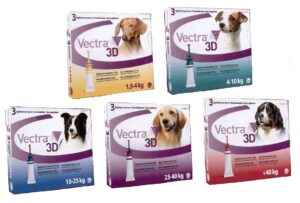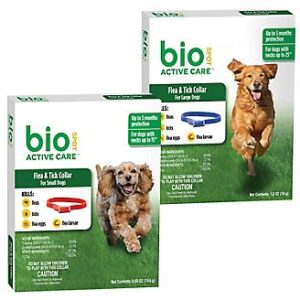Shoo Fly! Dont Bother Me!
When it comes to your dog’s parasite prevention plan, a combination attack is best. You should use a heartworm preventative in combination with one of these vet recommended repellents.
Vectra 3D

Side effects:
There is a potential for chemical burns at the site of application. Additionally, the ointment may cause restlessness and anxiety. This may be a direct result of the treatment or it may indicate irritation at the site to which it was applied. The treatment may also cause lethargy, panting, racing heart, loose stool, vomiting, fever, and excessive thirst.
Active ingredients:
• Permethrin – a synthetic form of an insecticidal compound produced by the chrysanthemum flower and degrades quickly in contact with soil and water. Put directly on the skin, typically less than 1% of active ingredients is absorbed into the body.
• Dinotefuran – disrupts an insect’s nervous system and results in the cessation of feeding within several hours of contact and death shortly after. mammals. It is specific for insects and does not bind to a mammal’s nervous system. It works through contact with the skin and is quickly eliminated from the body (in urine) if accidentally ingested.
• Pyriproxyfen – mimics a natural hormone in insects and disrupts their growth, primarily affecting insects and eggs. It’s considered low in toxicity for humans and other mammals.
K9 Advantix II

Side effects:
Sensitivity at the application site, skin irritation including scratching, discomfort, and redness, gastrointestinal discomfort, and lethargy.
Active ingredients:
• Imidacloprid – an insecticide that acts as an neurotoxin to insects and relatively harmless to mammals.
• Permethrin – classified as pyrethroid, which is a man made chemical developed to be similar to another naturally occurring insecticide called pyrethrum. Pyrethrum comes from the chrysanthemum plant, and it is highly rated in the pest control space.
• Pyriproxyfen – mimics a natural hormone in insects and disrupts their growth, primarily affecting insects and eggs. It’s considered low in toxicity for humans and other mammals.
BioSpot

Side effects:
May include signs of skin irritation such as redness, scratching, or other signs of discomfort. Gastrointestinal signs such as vomiting or diarrhea have also been reported
Active ingredients:
• Etofenprox – pyrethroid derivative which is used as an insecticide
• Piperonyl Butoxide – no pesticidal activity of its own, it enhances the potency of certain pesticides such as carbamates, pyrethrins, pyrethroids, and rotenone
• M-octyl bicycloheptene dicarboximide – an insecticide synergist that is always co-formulated with one or more active ingredients belonging to synthetic pyrethroids and pyrethrins. It enhances the pesticide properties of other insecticides.
• Pyriproxyfen – mimics a natural hormone in insects and disrupts their growth, primarily affecting insects and eggs. It’s considered low in toxicity for humans and other mammals.
• (S)-Methoprene – a juvenile hormone analog which acts as a growth regulator when used as an insecticide
None of these options are safe to use on or around cats. Talk to your vet about other options if you are living with both.
Never use human bug repellents on your dog or cat. The two most common ingredients in insect repellent for humans are DEET and Picaridin, which can cause vomiting, staggering, irritation and seizures. For this reason, you should also not let your dog or cat lick your skin after applying bug spray.
